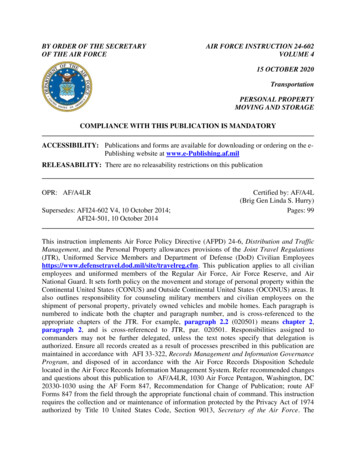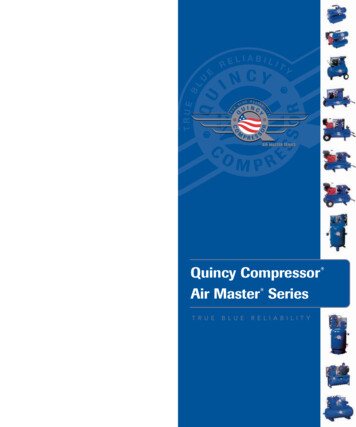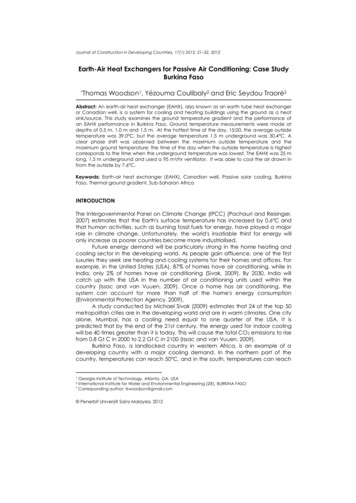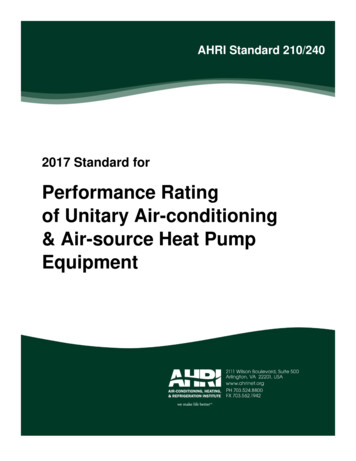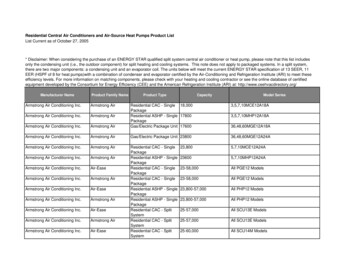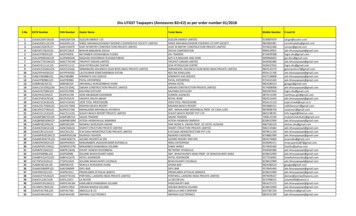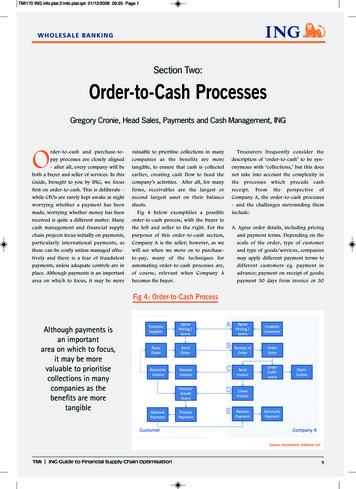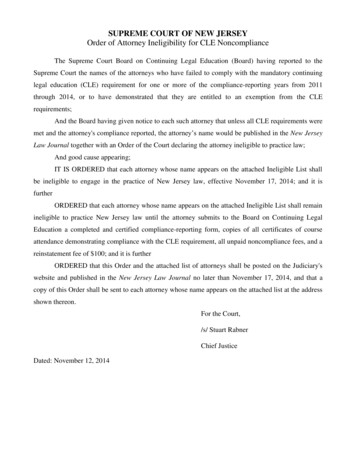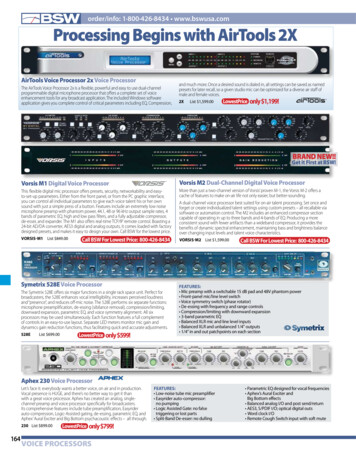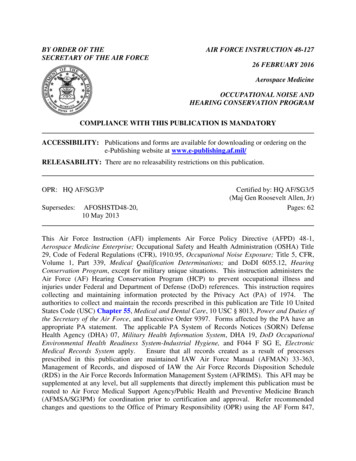
Transcription
BY ORDER OF THESECRETARY OF THE AIR FORCEAIR FORCE INSTRUCTION 48-12726 FEBRUARY 2016Aerospace MedicineOCCUPATIONAL NOISE ANDHEARING CONSERVATION PROGRAMCOMPLIANCE WITH THIS PUBLICATION IS MANDATORYACCESSIBILITY: Publications and forms are available for downloading or ordering on thee-Publishing website at www.e-publishing.af.mil/RELEASABILITY: There are no releasability restrictions on this publication.OPR: HQ AF/SG3/PSupersedes:AFOSHSTD48-20,10 May 2013Certified by: HQ AF/SG3/5(Maj Gen Roosevelt Allen, Jr)Pages: 62This Air Force Instruction (AFI) implements Air Force Policy Directive (AFPD) 48-1,Aerospace Medicine Enterprise; Occupational Safety and Health Administration (OSHA) Title29, Code of Federal Regulations (CFR), 1910.95, Occupational Noise Exposure; Title 5, CFR,Volume 1, Part 339, Medical Qualification Determinations; and DoDI 6055.12, HearingConservation Program, except for military unique situations. This instruction administers theAir Force (AF) Hearing Conservation Program (HCP) to prevent occupational illness andinjuries under Federal and Department of Defense (DoD) references. This instruction requirescollecting and maintaining information protected by the Privacy Act (PA) of 1974. Theauthorities to collect and maintain the records prescribed in this publication are Title 10 UnitedStates Code (USC) Chapter 55, Medical and Dental Care, 10 USC § 8013, Power and Duties ofthe Secretary of the Air Force, and Executive Order 9397. Forms affected by the PA have anappropriate PA statement. The applicable PA System of Records Notices (SORN) DefenseHealth Agency (DHA) 07, Military Health Information System, DHA 19, DoD OccupationalEnvironmental Health Readiness System-Industrial Hygiene, and F044 F SG E, ElectronicMedical Records System apply.Ensure that all records created as a result of processesprescribed in this publication are maintained IAW Air Force Manual (AFMAN) 33-363,Management of Records, and disposed of IAW the Air Force Records Disposition Schedule(RDS) in the Air Force Records Information Management System (AFRIMS). This AFI may besupplemented at any level, but all supplements that directly implement this publication must berouted to Air Force Medical Support Agency/Public Health and Preventive Medicine Branch(AFMSA/SG3PM) for coordination prior to certification and approval. Refer recommendedchanges and questions to the Office of Primary Responsibility (OPR) using the AF Form 847,
2AFI48-127 26 FEBRUARY 2016Recommendation for Change of Publication; route AF Forms 847 from the field through theappropriate functional chain of command. The authorities to waive wing/unit level requirementsin this publication are identified with a Tier number (“T-0, T-1, T-2, T-3”) following thecompliance statement. See AFI 33-360, Publications and Forms Management, Table 1.1. for adescription of the authorities associated with the Tier numbers. Submit requests for waiversthrough the chain of command to the appropriate Tier waiver approval authority, or alternatively,to the publication OPR for non-tiered compliance items. The use of the name or mark of anyspecific manufacturer, commercial product, commodity, or service in this publication does notimply endorsement by the Air Force.All AF Active Duty, Reserve, and National Guard military and civilian personnel (includingReserve technicians and Reserve Component military Reserve technicians) are covered by thisinstruction. (Note: Air Reserve (AR) and Air National Guard (ANG) will collectively bereferred to as Air Reserve Component (ARC)). This includes all appropriated fund, nonappropriated fund, seasonal, and temporary personnel. Foreign nationals employed by theUnited States Air Force (USAF) under a direct or indirect hire arrangement are also includedunless exempt by other agreements. Foreign national military personnel assigned to the USAFare included, unless other preventive measures and medical care are not provided by AF.Contractors must comply with state and federal noise standards, and are exempt from compliancewith this instruction. Contract personnel should not be enrolled in the AF HCP unless HCPservices are included in the contract. HCP services are not normally included in contracts. Thisinstruction does not apply to community noise situations. Referenced American NationalStandards Institute’s (ANSI) standards may be obtained for a fee from ANSI athttp://webstore.ansi.org.SUMMARY OF CHANGESThis document, AFI 48-127, replaces Air Force Occupational Safety and Health (AFOSH)Standard 48-20, Occupational Noise and Hearing Conservation Program, has been substantiallyrevised and must be completely reviewed. This instruction identifies the Tier waiver authoritiesas approved by the Inspector General Advisory Board. Major changes include baselineaudiograms for all new officer and enlisted accessions and hearing related fitness and riskevaluations are to close 45 days after determination that an evaluation is required.1.Overview. .32.Roles and Responsibilities. .4
AFI48-127 26 FEBRUARY 20163Attachment 1— GLOSSARY OF REFERENCES AND SUPPORTING INFORMATION27Attachment 2— HAZARDOUS NOISE SURVEILLANCE36Attachment 3— CERTIFICATION AND EQUIPMENT STANDARDS46Attachment 4— HEARING PROTECTION49Attachment 5— FITNESS AND RISK EVALUATIONS56Attachment 6— HEARING CONSERVATION DIAGNOSTIC CENTERS(HCDC)/HEARING CONSERVATION CENTERS (HCC) ANDREFERRAL CRITERIA59Attachment 7— OWCP HEARING LOSS MEDICAL REQUIREMENTS ASPARAPHRASED FROM DOL OWCP HEARING LOSS SECTIONINSTRUCTIONS621. Overview.1.1. The USAF HCP is a component of the Occupational and Environmental Health (OEH)Program, and is a command-driven program designed to reduce or eliminate hazardous noiseexposure to workers and protect workers from the harmful effects of hazardous noise, whileenhancing combat and operational capabilities. This process must occur across the full lifecycle of acquisition, sustainment, and support for weapons systems, munitions and othermateriel systems. This requires identifying all areas where workers are exposed to hazardousnoise and reducing exposure through engineering or administrative controls, or personalprotective equipment (PPE). (Also, refer to AFI 91-203, Air Force ConsolidatedOccupational Safety Instruction). One key to accomplishing these goals is an educationprogram that explains the individual’s role in protecting their hearing to include hazardousnoise exposures on and off duty and how to mitigate those threats.1.2. DoDI 6055.12 requires all DoD Components to implement a comprehensive programand written plan for hearing conservation when personnel are occupationally exposed asdescribed in DoDI 6055.12. This instruction meets the intent and requirements of DoDI6055.12 and reflects the unique functions, capabilities, and procedures of the Air Force HCP.1.3. For Joint Bases, this instruction is followed unless specific processes and provisions,meeting the intent and requirements of OSHA and DoDI 6055.12, are detailed in theMemorandum of Agreement.1.4. IAW AFI 48-145, Occupational and Environmental Health Program, hearingconservation issues will be considered through the Occupational and Environmental HealthWorking Group (OEHWG) just as any other occupational exposure.1.5. HCP requirements should be covered with other OEH program responsibilities inmemorandums of agreement as discussed in AFI 48-145.1.6. This AFI does not encompass audiograms for new accessions (officer and enlisted),conducted by the Department of Defense Hearing Center of Excellence.
4AFI48-127 26 FEBRUARY 20162. Roles and Responsibilities.2.1. Deputy Assistant Secretary of the Air Force for Environment, Safety andInfrastructure(SAF/IEE) will:2.1.1. As delegated by the Assistant Secretary of the Air Force for Installations,Environment and Energy (SAF/IE), provide policy, guidance, direction and oversight ofall matters pertaining to the formulation, review and execution of plans, policies,programs and budgets relative to the Environment, Safety and Occupational Health(ESOH) programs. Oversee implementation of those programs IAW AFPD 90-8,Environment, Safety and Occupational Health Management and Risk Management.2.1.2. Ensure Air Force operations involving occupational and combat-related exposureto hazardous noise establish and maintain HCPs in compliance with Federal and DoDrequirements. Such programs encompass the minimum requirements in DoDI 6055.12.2.2. Air Force Surgeon General (AF/SG) will:2.2.1. Provide strategic direction and policy to execute the AF HCP.2.2.2. Appoint the AF/SG’s Audiology Consultant.2.2.3. Support Combatant Commanders to establish hearing testing capabilities intheaters of operation whenever appropriate.2.3. Surgeon General Aerospace Medicine Policy and Operations Division (AF/SG3P) will:2.3.1. Serve as the principal AF point of contact with Federal and DoD agenciesregulating occupational exposure to hazardous noise.2.3.2. Develop policy and provide coordination on hearing conservation matters in theAF.2.3.3. Provide policy execution guidance to support installations in interpreting andimplementing the HCP requirements in DoDI 6055.12 and this instruction.2.3.4. In conjunction with the AF SG’s Audiology Consultant, identify USAF HearingConservation Diagnostic Centers (HCDC) and Hearing Conservation Centers (HCC)used for the evaluation of personnel with hearing loss in support of the HCP. ReferenceAttachment 6 for a list of authorized HCDC/HCCs.2.4. Headquarters Air Force Safety Center (AFSEC) will coordinate with AF/SG3P forsafety requirements associated with hazardous noise exposure (T-0).2.5. Air Force Medical Operations Agency (AFMOA) will:2.5.1. Allocate funding to resource and equip installations to assist with meeting theHCP requirements (T-1).2.5.2. Ensure the gaining Military Treatment Facilities (MTFs) have funds to send allnew Air Force audiologists to a hearing conservation program-training course at USAFSchool of Aerospace Medicine (USAFSAM) within one year of assignment to first dutystation for active duty or within the first year of employment for civilian audiologists.Contract audiologists hired to perform hearing conservation program duties may attend
AFI48-127 26 FEBRUARY 20165training at USAFSAM or a civilian equivalent training approved by the AF SG’sAudiology Consultant in accordance with contract management policy (T-0).2.6. Major Commands (MAJCOMs) will:2.6.1. Coordinate with the AF/SG’s audiology consultant to identify and designate ahearing conservation consultant (e.g., a regional HCDC/HCC or an OccupationalMedicine clinic) to oversee the command HCP.2.6.2. Allocate resources to staff and equip the HCDC/HCCs within their area ofresponsibility to provide regional HC referral support. Reference Attachment 6 foradditional information.2.6.2.1. HCDCs and HCCs must consist of an audiologist and support staff.2.6.2.2. At a minimum, testing capabilities will include diagnostic audiometerequipment sufficient to complete a full comprehensive hearing exam, a full range ofimmittance, electrophysiological, and otoacoustic emissions equipment.2.6.3. Utilize the ESOH Council as the executive forum to oversee the performance ofthe HCP and advocate for resource requirements when necessary.2.7. Within Air Education and Training Command:2.7.1. The 2nd AF will ensure all basic military trainees will receive an audiogram priorto or within the first week of training.2.7.2. The Air University Commander will ensure all Basic Officer Training, Academyof Military Science and direct Commissioned Officer Training students will receive anaudiogram during training.2.8. Assistant Secretary of the Air Force for Acquisition (SAF/AQ) will:2.8.1. Ensure Acquisitions Program Offices include personnel noise study data onsystems in the Programmatic Environment, Safety, and Occupational Health Evaluations(PESHE) and obtain formal coordination of new and updated PESHEs from theirsupporting Surgeon General offices, as required by AFI 63-101/20-101, IntegratedLifecycle Management. The coordinating Surgeon General office shall provide copies ofthe PESHE to the USAFSAM Occupational and Environmental Health Department(USAFSAM/OE).2.8.2. Ensure new equipment and weapons systems being considered for fielding havethe lowest sound emission levels that are technologically and economically possible, andcompatible with performance and environmental requirements. Title 42 USC Section4914, Development of Low-Noise-Emission Products, applies.2.9. Commander, Air Force Materiel Command (AFMC) will ensure that the AF ResearchLaboratory (AFRL) 711th Human Performance Wing (HPW) will:2.9.1. Appoint an occupational medicine consultant who provides consultation for theAF HCP (T-2).2.9.2. Execute the research and consultative missions related to noise evaluation andcontrol via Acoustic and Vibration Center of Excellence (T-2). The Acoustic andVibration Center of Excellence will have standing members including the 711
6AFI48-127 26 FEBRUARY 2016HPW/Human Effectiveness Directorate (RH), USAFSAM/OE, and USAFSAM PublicHealth (USAFSAM/PH) (T-2). The Acoustic and Vibration Center of Excellence singlepoint of contact (POC) is the ESOH Service Center at esoh.service.center@us.af.mil,888-232-3764, or DSN798-3764. Direct all requests for support and any questions aboutthese responsibilities to this POC. The Acoustic and Vibration Center of Excellencewill:2.9.2.1. Provide consultative services to measure, evaluate, and recommend controlsand solutions for occupational noise concerns within the AF (T-2). Develop andrecommend noise criteria, assessment, and control strategies to acquisition programs(T-2).2.9.2.2. Conduct research relative to noise exposure criteria and speech intelligibility(T-2).2.9.2.3. Represent the USAF on ANSI accredited standards committees relative tonoise S1 (acoustics), S3 (bioacoustics), and S12 (noise) (T-2).2.9.2.4. Conduct acoustic research relative to human performance in USAFenvironments (T-2).2.9.2.5. Conduct measurements to quantify the performance of attenuation of hearingprotectors, and attenuation and speech intelligibility of communicationheadsets/microphones (T-2).2.9.2.6. Characterize the ground run-up, flyover, and interior noise levels of aircraft(T-2).2.9.2.7. Characterize high-level continuous noise, greater than 130 decibels (dB), andimpulsive noise greater than 170 dB (T-2).2.9.2.8. Recommend to AF/SG, USAF exposure criteria for continuous andimpulsive noise (T-2).2.9.2.9. Provide data/information and consultation related to historic acousticalassessments performed by the 711 HPW and professional organizations to baseBioenvironmental Engineering (BE) (T-2).2.9.2.10. Provide consultation and assistance on the selection of hearing protectors(T-2).2.9.2.11. Provide data/information and consultation on unique or complex acousticenvironments (T-2).2.9.2.12. Develop guidance on hierarchy of noise measurement techniques (T-2).2.9.2.13. Represent USAF with federal agencies and national professionalorganizations that set standards and standards of practice in the ESOH disciplines (T2).2.9.2.14. Maintain a repository of relevant references in noise and hearing protection(T-2).2.9.2.15. Develop and provide guidance and oversight for the AF HCP (T-2).
AFI48-127 26 FEBRUARY 201672.9.2.16. Evaluate AF HCP effectiveness based performance measures as defined byAFMSA, HAF, and DoDI 6055.12 (T-0). At a minimum, performance measuresinclude the incidence of significant threshold shift (STS) and permanent thresholdshift (PTS), and audiogram compliance rates for all workers enrolled in the HCPprogram (including threshold shift follow-up rates).2.9.2.17. Provide AFMSA/SG3PM, MAJCOMs and base-specific reportscommunicating the results of the performance measures on a routine basis or at leastannually (T-2).2.9.2.18. Evaluate and report recommendations for corrective action to installationlevel Hearing Conservation Program Manager (HCPM) and to the MAJCOMs(SGPM) to improve data quality in the Department of Defense Occupational andEnvironmental Health Readiness System (DOEHRS) Data Repository (DR) on aroutine basis (at least annually) and upon request (T-2).2.9.2.19. Appoint an appropriately trained audiologist to serve as the AF HearingConservation Program Manager (AF HCPM). This individual will serve as a primaryrepresentative to the DoD HC and Readiness working group, the DoD DOEHRS-HCfunctional users group and as the consultant for DOEHRS-HC and DR in the AirForce (T-1).2.9.2.20. Provide training to support the HCP (T-2).2.9.2.20.1. Provide DR orientation and program management training for newlyassigned military, civilian and contract AF audiologists, as needed (T-2).2.9.2.20.2. Conduct formal Council for Accreditation in Occupational HearingConservation (CAOHC)-approved training for DoD personnel (military andcivilian) who perform audiograms (T-2). Reference Attachment 3.2.9.2.20.2.1. Provide AF certification numbers to students upon completionof CAOHC training (T-2). If AF certification numbers are unavailable the lastday of training, they will be provided within 10 days of CAOHC training.2.9.2.20.2.2. Track HC certification numbers for personnel who are trainedIAW the CAOHC (T-2). Note: AF personnel who receive CAOHC-approvedtraining at civilian agencies must register certification information with theAF HCPM and receive an AF certification number prior to conductingaudiometric testing. AF personnel who are CAOHC trained by a DoDcomponent will use the certification number issued by that Service.2.9.2.20.3. Conduct training for Public Health (PH) Officers and skill-levelappropriate 4E0X1 using course material that addresses components of HCPadministration/management (T-2). Provide CAOHC hands-on and didacticDOEHRS-HC training for 4E0X1 personnel for the HCP (T-2).2.9.2.20.4. Conduct training for providers on audiogram review, audiogramconsultation, referrals, and fitness and risk evaluations (T-2).2.9.2.20.5. Conduct training for BE technicians and officers that addressesidentification, assessment, control and documentation (in DOEHRS-IndustrialHygiene (IH)) of hazardous noise exposures as outlined by Federal, DoD and AF
8AFI48-127 26 FEBRUARY 2016standards (T-2).2.9.2.20.6. Provide HC orientation training for newly assigned military, civilian,and contract AF audiologists, as needed (T-2).2.9.2.20.7. Produce annual reports on the percentage of hazardous noiseworkplaces characterized and the index of unacceptable noise exposures, asoutlined in DoDI 6055.12, and provide to AFMSA/SG3PB (T-0).2.10. Wing Commanders will:2.10.1. Provide oversight and support for an installation hazardous noise reduction andprotection program (T-1).2.10.2. Ensure HCP is a standing agenda item for the ESOH Council as outlined in AFI90-801, Environment, Safety, and Occupational Health Council (T-2). Programeffectiveness will be evaluated; information to be briefed may include the programperformance metrics, as outlined in DoDI 6055.12, the number of shops and personnel onthe program, incidence rate of STS and PTS, percent of workers requiring follow-up, etc.2.11. Squadron Commanders will:2.11.1. Ensure workplaces and Workplace Supervisors comply with all AF HCP, DoD,and OSHA requirements (e.g., workplace noise hazard assessments, ensuring monitoringof hazardous noise-exposed personnel including pre-placement, periodic, and terminationaudiograms; training of noise-exposed personnel, and supplying hearing protectiondevices and enforcing use, as appropriate) (T-0).2.11.2. Participate in the review of the workplace hazards as process owners to identifyactions taken to mitigate hazardous noise (i.e., efforts to procure equipment which doesnot generate hazardous noise, applying engineering and administrative controls) (T-2).2.
States Code (USC) Chapter 55, Medical and Dental Care, 10 USC § 8013, Power and Duties of the Secretary of the Air Force, and Executive Order 9397. Forms affected by the PA have an appropriate PA statement. T


